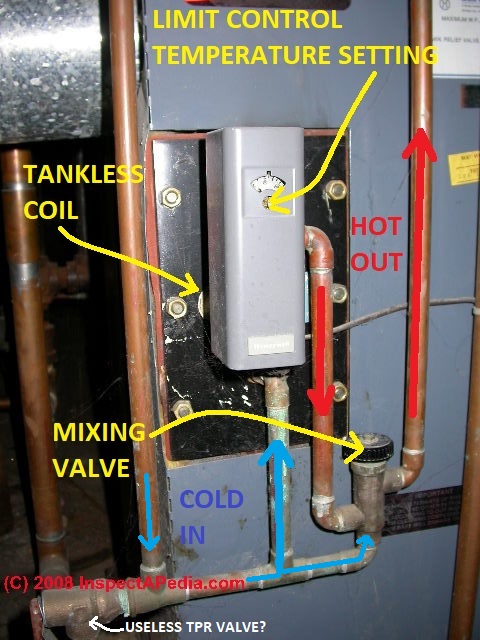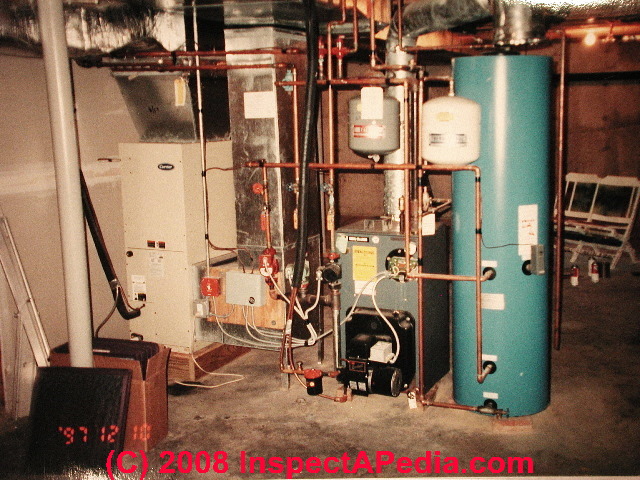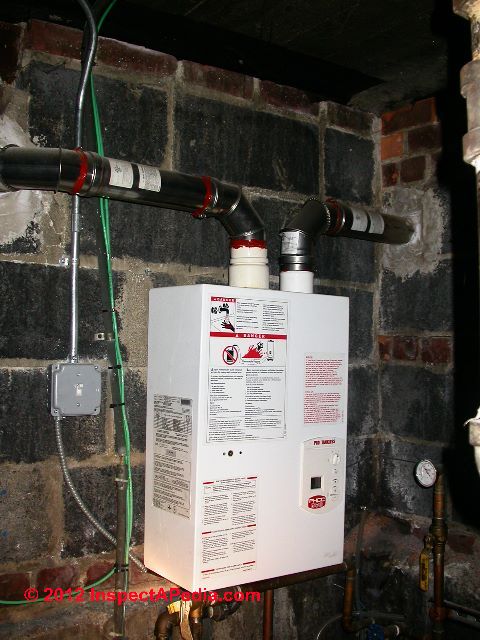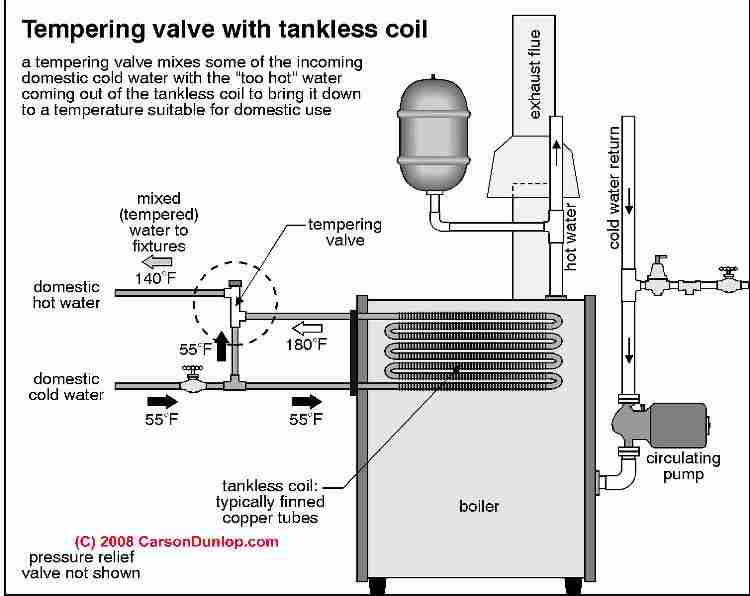 Tankless Coil Hot Water
Tankless Coil Hot Water
Abaondonment or
Conversion
Abandon, leave in place, or use a Tankless Coil to Heat a Separate Water Tank
- POST a QUESTION or COMMENT about the procedure for abandoning a tankless coil to use other methods for making hot water
Abandoning or converting a tankless coil hot water heating system:
Hot water supply improvements by converting from a tankless coil to something else. This article explains whether or not it makes sense to convert tankless coil used for making domestic hot water into an alternative hot water system such as using it to heat a separate hot water tank.
InspectAPedia tolerates no conflicts of interest. We have no relationship with advertisers, products, or services discussed at this website.
- Daniel Friedman, Publisher/Editor/Author - See WHO ARE WE?
Tankless Coil Abandonment or Conversion Options
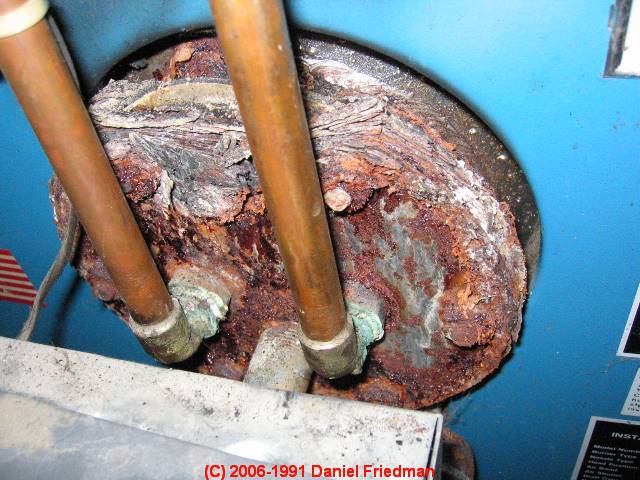 A tankless coil hot water system uses a finned copper coil inserted right into the hot heating boiler water to heat domestic hot water as water is run through the interior of the coil.
A tankless coil hot water system uses a finned copper coil inserted right into the hot heating boiler water to heat domestic hot water as water is run through the interior of the coil.
Heat from the boiler water is transferred through the coil fins and tubing into water passing through the interior of the coil on its way to the user.
When a tankless coil is leaky and you are facing a costly repair, that's a good time to consider the option abandoning the coil and installing an alternative hot water source.
Article Contents
- ABANDONING a TANKLESS COIL - two cases: intact or leaky coil
- SWITCHING FROM A TANKLESS COIL to INDIRECT WATER HEATER
Photo above: a badly-corroded leaky tankless coil. This tankless coil must be either replaced or abandoned entirely.
...
Abandoning a Tankless Coil Hot Water System
If you prefer to stop using a tankless coil for making domestic hot water (for washing and bathing) you can certainly do so by installing a different hot water source such as an independent water heater or an indirect water heater that is warmed as a separate heating zone on your boiler system.
Abandoning a Tankless Coil That is Not Leaking
Inspect the face of the tankless coil and its mounting bolts and any other penetrations (such as for an aquastat) at the coil plate for leaks and corrosion.
If no leaks or corrosion are found then your plumber will simply turn off valves controlling cold water in to the coil and hot water flowing out of the tankless coil.
Then she should cut off the cold water line into the coil and hot water line out of the coil, capping those off so that should the coil itself develop a leak in the future boiler water won't leak out of the system.
Separately the plumber will then connect the cold-in and hot-out piping to your new hot water source.
Abandoning a Leaky Tankless Coil
Watch out: if the tankless coil is leaking around the coil mounting plate or its mounting bolts, simply turning off and disconnecting the tankless coil inlet and outlet pipes we mentioned above won't be sufficient to stop leaks that may damage or even ruin the heating boiler itself.
In this case, because it's usually necessary to completely remove the tankless coil anyway to replace a leaky gasket or to re-seal leaky mounting bolts, we recommend replacing the entire tankless coil assembly with a "bliind" round or rectangular plate of the same dimensions as the original coil mounting plate.
The old leaky coil is discarded and the new blind plate mounted in place to seal the front of the boiler.
Really? Well not always. IF, in addition to the "cold-in" and "hot-out" pipes passing through the coil mounting plate there was also a tapping to support a boiler aquastat control, AND IF that control is still needed to control the boiler (it may not be as you're no longer making domestic hot water by that coil) then your new "blind plate" will need to include the same tapping to re-mount that control.
In our photo below a boiler limit control is mounted right through the square tankless coil mounting plate - this control will still be needed aftre abandoning the tankless coil.
If this plate isn't leaky then the plumber will cut and cap the COLD-IN and HOT-OUT pipes indicated in our photo.
...
Converting a Tankless Coil to Indirect Water Heating
Photo above: at right, a green, indirect-fired water heater, center: the heating boiler, and at far left a water-to-air heating and cooling system. Notice the boiler control aquastat mounted throughthe round black "blind" coil plate (no tankless coil just a plate with a tapping for the primary control mount).
Bottom line: an effective way to convert your domestic hot water source from a tankless coil is to abandon the tankless coil entirely and to install a separate indirect fired water heater - a hot water water tank that provides a larger reservoir of hot water and that is heated as a separate heating zone by your heating boiler.
In this design a circulator pump sends hot boiler water through a loop of pipe that in turn runs water through a heating coil that is immersed inside the indirect water heater tank.
In essence, this approach turns the concept of a boiler tankless coil inside out.
- In a tankless coil installation
domestic hot water is run though a coil that is immersed in the heating boiler (or is along side it as a side arm coil) and the domestic hot water is heated as it passes through the coil. - In an indirect water heater installation
boiler hot water is run through a coil that is immersed in the hot water tank, and the volume of water stored inside the indirect water heater tank is heated by that coil.
Because the volume of water that is found inside the heating boiler itself and the loop of heating zone pipes, radiators, baseboards, and tne (new) indirect water heater heating coil (that is inside the indirecdt water heater tank) is fixed and unchanging, the problem of corrosivity that plagues many tankless coil hot water systems is avoided.
If you install an indirect water heater, the tankless coil on your heating boiler will be abandoned completely - it will no longer be used - as we describe in detail
What is the difference between an indirect-fired water heater and the tankless coil on a heating boiler?
A tankless coil water heater
delivers "on demand" hot water by sending building cold water through a coiled copper pipe that is immersed in the hot heating boiler's own water. The boiler water heats the coil that in turn heats water passing through it.
However a tankless coil doesn't provide endless hot water because cold water passing through the coil will take heat out of the boiler faster than the boiler's burner can put heat back in.
Tankless coil water heaters are described in detail
at TANKLESS COILS - home
An indirect-fired water heater
uses a separate reservoir tank of "hot water" (a hot water tank) that is heated by circulating hot water from the heating boiler (photo below-right, short and gray to left of the tall blue water tank) through a heat exchanger "coil" mounted in the bottom of the water tank.
The domestic hot water used by the building occupants is inside the water tank.
The quantity of hot water available is a function of the size of that tank, typically 50 gallons, plus the operating temperature range (higher temperature + mixing valve gives more than 50 gallons of hot water). Usually, any indirect fired water heater tank will provide a greater quantity of domestic hot water than can the tankless coil.
At INDIRECT FIRED WATER HEATERS we describe indirect-fired water heaters in detail.
Why do people convert from using a boiler-mounted tankless coil to indirect-fired water heaters?
The specifications for a typical tankless coil / hot water heating boiler indicate that the maximum flow rate through the coil has to be limited, say to perhaps 2.5 to 5 gallons per minute.
Running hot water faster than that will mean the hot water isn't so hot - it needs time (slow passage through the coil) to absorb heat, and it means that you will run out of hot water sooner (sucking heat out of the boiler faster).
Those specifications also typically promise only 5 minutes of hot water supply (that's 25 gallons). Actually some happy users of tankless coils get more than that by combining a flow restricter, high boiler set temperature, and a tempering valve or mixing valve
(see MIXING / ANTI-SCALD VALVES) at the coil .
At HOT WATER QUANTITY IMPROVEMENT we discuss various ways to get more hot water in a home. One of these
Which gives me more hot water: a tankless coil on a boiler or an indirect-fired water heater?
Let's mention again the performance limits of a conventional boiler-mounted tankless coil.
Keep in mind we're talking about a finned copper coil immersed into the heating water found inside a home heating boiler whose primary design purpose was heating the home, not making domestic hot water for washing and bathing.
The hot water quantity available from a tankless coil depends on
- The hot water flow rate - how much hot water you run at a time or how fast you run hot water out of one or more plumbing taps
- The heating boiler's input BTUh rate - the burner's capacity to put heat back into the boiler
- The incoming cold water temperature - how much energy will be required to warm the incoming water
- The setting of anti-scald devices in the building - that control the rate at which hot water is drawn, separately from how far the hot water tap or valve has been opened.
Ultimately the cold water running through the boiler's coil will have absorbed so much heat that the boiler water temperature drops and the burner turns on. But unless the hot water flow is turned off, the burner won't (in a normal residential heating boiler system) be able to heat water faster than it's being run through the coil.
Another Option: On Demand Tankless Water Heaters
Note that unlike a tankless coil, and unlike an indirect water heater, an on-demand tankless water heater (illustrated below) is designed to heat water up to an acceptable temperature for as long as water is flowing through that heater type.
Tankless water heaters are described in detail
...
Other Tankless Coil Conversion Idea: hook up a circulating pump and hot water tank to the existing tankless coil system?
Some homeowners and fewer plumbers have tried to increase the volume of domestic hot water by keeping an existing tankless coil in use, but using it to heat a separate tank of domestic hot water by circulating water to and from the water tank through the tankless coil.
And indeed, it may be possible to produce a larger volume of hot water for domestic use than the tankless coil can provide "on demand".
This is not an approach that we recommend, particulary if the present tankless coil is leaky and needs repair or replacement, though we've inspected a few installations of this design.
...
...
Continue reading at TANKLESS COIL HOT WATER INCREASE or select a topic from the closely-related articles below, or see the complete ARTICLE INDEX.
Or see these
Tankless Coil Water Heater Articles
- TANKLESS COILS - home
- AQUASTAT CONTROL FUNCTIONS
- BODY OVERHEATING HAZARDS
- CLOGGED PIPES / TANKLESS COIL DE-SCALE
- HOT WATER ANTI-SCALD REGULATIONS
- MIXING / ANTI-SCALD VALVES
- TANKLESS COIL ABANDONMENT or CONVERSION
- TANKLESS COIL HOT WATER HEATER TEMPERATURE CONTROL
- TANKLESS COIL HOT WATER INCREASE
- TANKLESS COIL INSTALLATION PROCEDURE
- TANKLESS COIL INTERNAL LEAKS INTO the BOILER
- TANKLESS COIL / HOT WATER COIL LEAKS
- TANKLESS WATER HEATERS - home
Suggested citation for this web page
TANKLESS COIL ABANDONMENT or CONVERSION at InspectApedia.com - online encyclopedia of building & environmental inspection, testing, diagnosis, repair, & problem prevention advice.
Or see this
INDEX to RELATED ARTICLES: ARTICLE INDEX to WATER HEATERS
Or use the SEARCH BOX found below to Ask a Question or Search InspectApedia
Ask a Question or Search InspectApedia
Try the search box just below, or if you prefer, post a question or comment in the Comments box below and we will respond promptly.
Search the InspectApedia website
Note: appearance of your Comment below may be delayed: if your comment contains an image, photograph, web link, or text that looks to the software as if it might be a web link, your posting will appear after it has been approved by a moderator. Apologies for the delay.
Only one image can be added per comment but you can post as many comments, and therefore images, as you like.
You will not receive a notification when a response to your question has been posted.
Please bookmark this page to make it easy for you to check back for our response.
IF above you see "Comment Form is loading comments..." then COMMENT BOX - countable.ca / bawkbox.com IS NOT WORKING.
In any case you are welcome to send an email directly to us at InspectApedia.com at editor@inspectApedia.com
We'll reply to you directly. Please help us help you by noting, in your email, the URL of the InspectApedia page where you wanted to comment.
Citations & References
In addition to any citations in the article above, a full list is available on request.
- Thanks to reader A Rossini, Katonah NY for email discussing getting more out of an old tankless coil hot water system - Feb. 2010.
- In addition to citations & references found in this article, see the research citations given at the end of the related articles found at our suggested
CONTINUE READING or RECOMMENDED ARTICLES.
- Carson, Dunlop & Associates Ltd., 120 Carlton Street Suite 407, Toronto ON M5A 4K2. Tel: (416) 964-9415 1-800-268-7070 Email: info@carsondunlop.com. Alan Carson is a past president of ASHI, the American Society of Home Inspectors.
Thanks to Alan Carson and Bob Dunlop, for permission for InspectAPedia to use text excerpts from The HOME REFERENCE BOOK - the Encyclopedia of Homes and to use illustrations from The ILLUSTRATED HOME .
Carson Dunlop Associates provides extensive home inspection education and report writing material. In gratitude we provide links to tsome Carson Dunlop Associates products and services.


